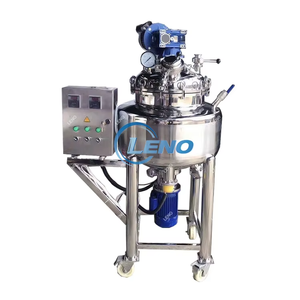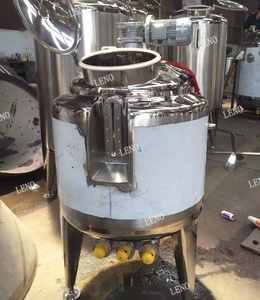
All categories
Featured selections
Trade Assurance
Buyer Central
Help Center
Get the app
Become a supplier

(2443 products available)



























A mixer for wastewater treatment comes in different types, each designed to carry out specific functions effectively and efficiently. Here are some of the common types of mixer for wastewater treatment:
Top-Mounted Mixers
Top-mounted mixers are mixing devices that are supported from above a treatment tank or basin. They consist of a drive unit and an anchor that is lowered through an open basin. The drive unit is usually an electric motor that provides enough power to the mixer. Top-mounted mixers are used to distribute organics evenly within the treatment plant or keep solids from settling.
Jet Mixers
Jet mixers are devices that use high-pressure water streams in order to create motion in wastewater. They have a piping system where water is pumped at high pressure. The mixing occurs when the high-pressure water creates a flow pattern in the wastewater. Jet mixers are often used in waste treatment plants where dilution and homogenization are the main objectives.
Bottom-Mounted Mixers
Bottom-mounted mixers are devices that are mounted at the bottom of a tank or basin. They usually consist of a vertical stirrer and a motor. The motor drives the vertical stirrer, which rotates to create a circular movement in the wastewater treatment plant. Bottom-mounted mixers are the ideal choice when quick dispersion of chemicals is needed. They can also be used for stabilizing various elements within the basin.
Floating Mixers
Floating mixers are devices that use a buoyant platform to stay on the surface of wastewater. They consist of a motor, a drive unit, and a platform that is used to support the mixer. The motor provides enough power to drive the mixing element, which circulates the wastewater in order to achieve the desired treatment. Floating mixers are often used in deep tanks or when there's a large fluctuation in volume.
The specifications of a wastewater treatment mixer will vary depending on the type, model, and capacity. Here are some typical specifications for some common wastewater treatment mixers:
Operating capacity
A specification indicates the volume or amount of mixer that a particular model can handle. For example, a wastewater treatment mixer with a 1000L operating capacity indicates that it can effectively mix or treat wastewater with a volume of up to 1000 liters.
Motor power
The motor power of a wastewater treatment mixer is indicated in horsepower (HP) or kilowatts (KW). A wastewater treatment mixer with a 5HP motor power means it can use a motor that has the power to drive the mixer at five horsepower. This particular motor power will be relevant in determining the speed and torque of the mixer.
Mixing speed
Mixing speed represents how fast the mixer rotates its blades or impellers through the motor power. It is shown in revolutions per minute (RPM). A wastewater treatment mixer with a 2000RPM mixing speed means that the impeller or blades of the mixer will make 2000 full rotations in one minute.
Material construction
Various types of materials like stainless steel, carbon steel, and polystyrene are used for different mixers. The mixer is made of corrosion-resistant, high-strength stainless steel. That is because it can withstand the impact of abrasive chemical components found in wastewater.
For mixing wastewater in treatment plants, regular maintenance is important to ensure the proper functioning of the mixer and reduce downtime. Some frequent maintenance tasks for a wastewater mixer include the following:
Industrial wastewater mixers for treatments are used in numerous industries and facilities that need treatment options, including farms and the food industry. Below are some of the key areas that need the mixers and how they use them.
Wastewater Treatment Plants
These plants use mixers in the digestion process. The bacteria breaking down waste require constant movemenats in the tank. The mixer ensures consistent mixing to enhance the bacteria's growth and waste breakdown.
Industrial Factories
Factories that produce hazardous materials or have large industrial processes leading to significant wastewater set-ups use mixers at their treatment plant. Industries like chemical, textile, and food and beverage can have wastewater with high organic matter. The mixers ensure even distribution of pollutants to enable efficient removal.
Ponds and Lagoons
Some municipalities and industries use natural treatment options like ponds and lagoons. They place mixers in the ponds to prevent stratification and ensure all layers of treated wastewater come through. The mixer helps nutrients in the pond support the growth of bacteria and other cleansing organisms.
Farm Facilities
Agricultural farms that handle large livestock or food processing generate organic wastewater. Farms like these make use of wastewater mixers to evenly distribute waste matter and accelerate decomposition of organic materials in the lagoon or open pond. This helps to reduce the foul odor that comes from decomposing matter.
Energy Recovery Facilities
Some wastewater treatment facilities use anaerobic digestion to generate biogas that they use to produce energy. They use mixers in the anaerobic digester to ensure even breakdown of organic matter to maximize the facility's energy output.
Wastewater particles
Understanding the particles in the wastewater and their density is key to selecting an appropriate mixer. The mapping of the wastewater system must be done, including the volume, the type, the thickness, and the temperature. If, for example, there are heavy particles like sand in the wastewater, a more powerful mixer like a turbine would be optimal.
Operation needs
The operating needs in the wastewater treatment plant also play a part in which mixer should be selected. The temperature and pressure of the wastewater must be mapped. If the wastewater mixer is to work at high temperatures or under pressure, a more robust mixer must be selected that can handle those conditions.
Maintenance
The maintenance requirements of the mixer should also be considered. How often will the mixer need to be maintained? Is it easy to clean and service? The more complex the mixer, the more maintenance it will require.
Costs
When choosing a wastewater mixer, it is crucial to consider the costs. The initial purchase price is only part of the total cost. Operating costs over the mixer's lifetime will probably add up to a much more significant sum than the initial purchase price. Therefore, it is essential to consider the operating costs when selecting a mixer.
Q1: What is the role of a mixer in a wastewater treatment plant?
A1: The mixer plays several vital roles in wastewater treatment. It ensures even distribution and eliminates settling. The mixer also facilitates the mixing of different wastewater components. It promotes gas exchange when aeration is part of the treatment process.
Q2: What are the trends in wastewater treatment mixers?
A2: The trend is moving toward energy-efficient mixers, which consume less power while maintaining the same efficiency. Another trend is the development of smart mixers that can be monitored and controlled remotely. These can be integrated into a wastewater treatment plant's overall automation system.
Q3: How does a wastewater mixer work?
A3: A mixer uses a rotating impeller to stir the liquid. The rotating impeller creates a circular flow pattern that draws the liquid downwards and pushes it outward. Some mixers may use compressed air to create bubbles in the liquid that helps propel the liquid in a circular pattern.
Q4: Which mixer is suitable for a wastewater treatment plant?
A4: Consider the type and volume of wastewater. The size of the treatment facility and the mixing task are other factors to consider. Things like energy consumption, operating cost, and maintenance requirements also matter. It is best to consult with an expert before deciding on the kind of mixer to use.